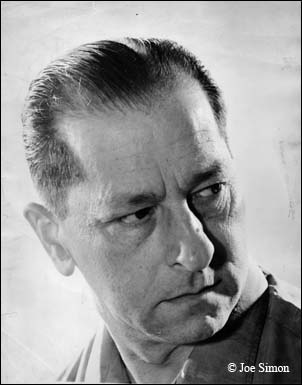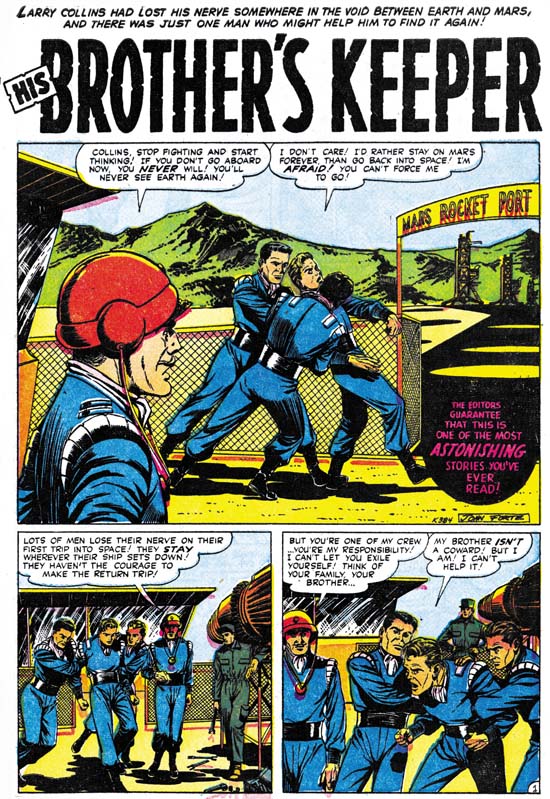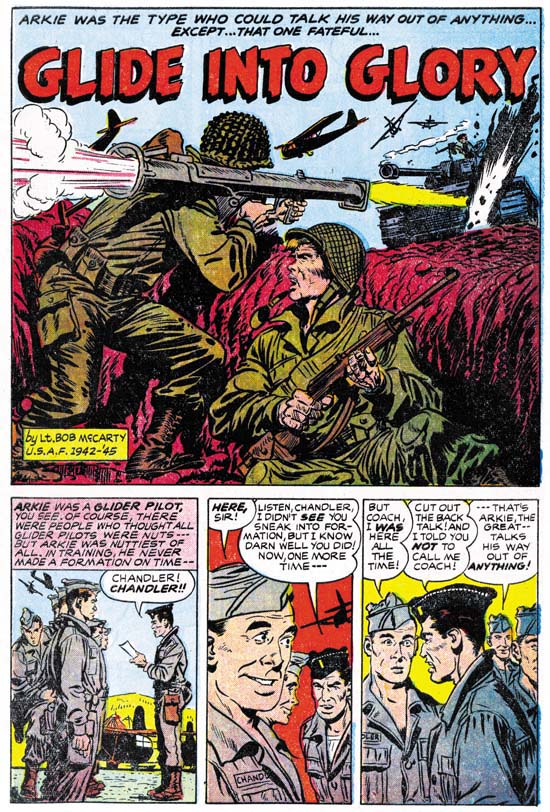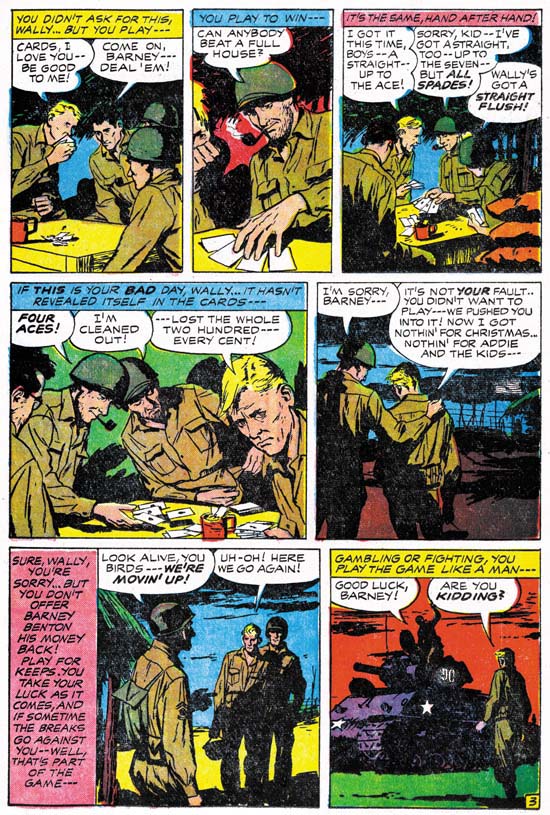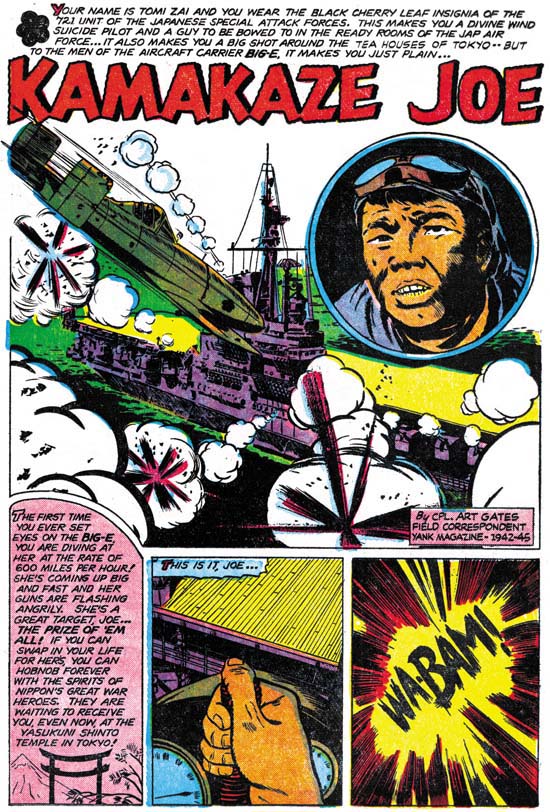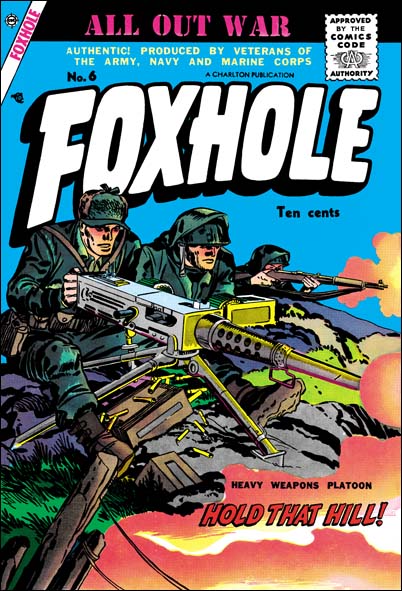
Foxhole #6 (September 1955) art by Jack Kirby
With issue #6 Foxhole looses focus a little bit. The cover still declares it was made by veterans and, except possibly for one story, this is true. One change that occurs is that the credit boxes have disappeared. Once again we must rely mostly on the style to identify the artist. For the first time one story shifts completely out of the WWII or Korean time frame. None of this affects the quality of the comic as a whole. With one exception, all the stories are great reads, penciled by some of the same talented artists that we have seen before. Further Jack Kirby is back! Jack provides two stories and that alone makes this issue memorable. Only two things dampen my enthusiasm for this comic. One of the stories really is not all that good and the cover is way below Kirby’s standard.
It is obvious that Simon and Kirby put much effort into their covers. I do not believe any other team or individual artist produced so many covers of such consistently high quality. Disappointing covers are very rare but Foxhole #6 is one of them. The last covers for Police Trap are also poor efforts. Even the last In Love suffers and that was drawn by Bill Draut. Bullseye #6 is a good cover, but the preceding one is not. So many below par covers from such a short period deserves some sort of explanation. I cannot offer a definitive one, but I suspect that the Simon and Kirby studio and the work practices it supported had broken down.
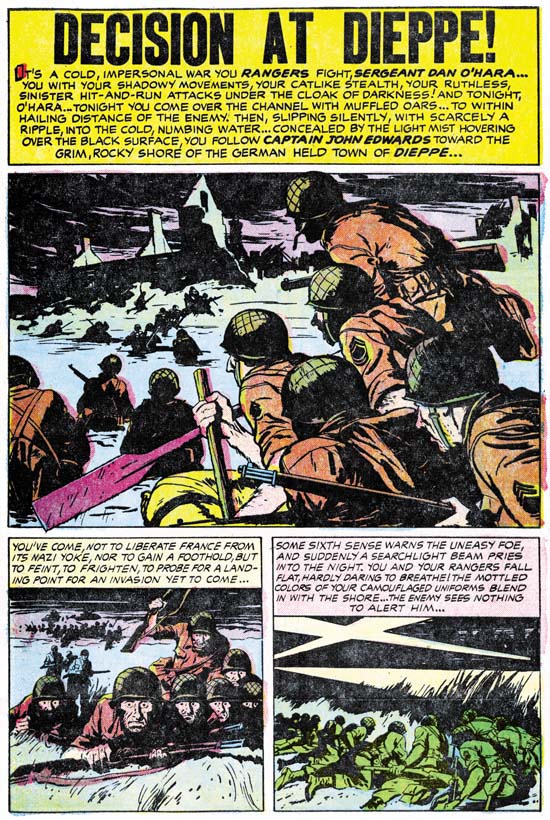
Foxhole #6 (September 1955) “Decision At Dieppe” page 1 art by Joe Albistur
A soldier gets wounded and separated from his unit during a commando probe of Germany held Dieppe. He is discovered by a Frenchman who hides him. The Germans take over the house to use as their headquarters effectively making the American soldier a prisoner. His hidden vantage point provides the soldier with the opportunity to observe the brutality of the German occupation.
This is Joe Albistur’s last effort for Foxhole. He would continue to provide some stories for the Prize romances but after a couple months that would end also. Albistur only worked for Simon and Kirby for about a year. Although he did provide enough material that during that time he really can be considered one of the usual suspects (artists who frequently provided work for Simon and Kirby). Like the other usual suspects (Bill Draut, Mort Meskin and John Prentice). Joe Albistur has his own unique style which is easily recognizable. I previously have admired his work for the Prize romances but his Foxhole art has left me even more impressed. Joe would do further comic book work after his Simon and Kirby period. I have not seen much of that work and what little I have seen does not look as good as his S&K material. Is this because I just have not seen enough of it or did Simon and Kirby provide the kind of freedom for Albistur’s style to flourish?
Without credits I cannot say who is responsible for the “Decision At Dieppe” script. In previous Foxhole stories Albistur’s writers were Jack Oleck and Jack Kirby. I really do not have a handle on Oleck’s style yet, but the writing of this story does not appear to have been by Kirby. It is wordier then Kirby’s writing and reads more like the work by someone with a writers background. “Decision At Dieppe” is a good story but I feel that it suffers a little from the effects of the Comic Code. There is one scene where the American soldier is discovered by a German orderly. The text box tells us that the American attacks the German before any alarm can be sounded. Although the art shows the initial confrontation the next scene shows the American alone. We are never provided with anything from the actual fight. Only from reading the text is the story understandable. I am not suggesting that the Comic Code actually censored this part of the story, just that the writer or artist wanted to avoid any possible rejection.

Foxhole #6 (September 1955) “Even Steven” page 1 art by Jack Kirby
I really like some of the artists whose work appeared in Foxhole. Still it is nice to see some more stories by Jack Kirby. “Even Steven” is a tale about the vicissitudes of war as told from the viewpoint of a German soldier. In it an American soldier is captured by the German who later is captured by some Americans. The actions of each mirror that of the other. Yet despite the two characters performing essentially the same actions, the readers reaction to each is not the same. The American soldier embodies good while the German is inherently evil. “Kamakaze Joe” was another story from Foxhole that adopted an enemy as the lead character. “Kamakaze Joe” used that enemy’s narration to provide an explanation of his motivations. While we may not be willing to accept his culture we can understand why a Kamakaze pilot did what he did. In “Even Steven” Kirby does not really attempt to provide any understanding of the German soldier. For Jack evil is a basic trait that does not need any explanation. This will be a one of Kirby’s recurring themes in the years to come.
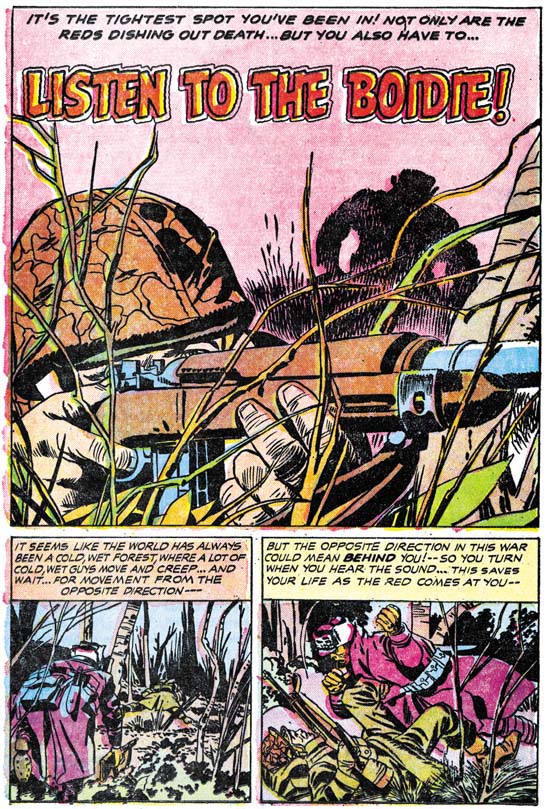
Foxhole #6 (September 1955) “Listen To The Boidie” page 1 art by Jack Kirby
“Listen To The Boidie” provides an example of another of Jack’s interests, that of comic absurdities occurring during events that normally would be considered as rather serious. An American line is being faced with an assault from Koreans. We are told this tale by a former Broadway press agent. The Koreans have been relentless and our soldier owes his life to the efforts of a soldier from the south. This southerner happens to be a crack shot with a rifle but his mains interests seems to be bird whistles. He is constantly trying to have the main character give him an audition.
You can trace Kirby’s interests from the start of his career to the end. They may evolve but they are generally present. However “Even Steven” and “Listen To The Boidie” seem especially characteristic of Jack Kirby’s later work. I do not think they would have been at all out of place had they been published in the title called The Losers that Kirby did in the mid ’70s.
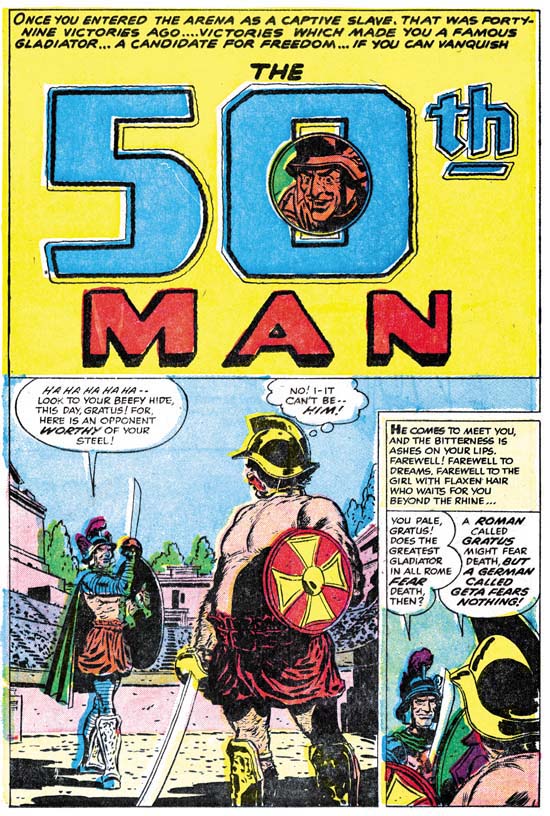
Foxhole #6 (September 1955) “The 50th Man” page 1 art by Bill Draut
With “The 50th Man” Foxhole #6 steps out of the WWII or Korean war time period. Heck it even leaves wartime combat entirely. We now enter the gladiator arena during the Roman empire. This story man seem out of place in a comic with the title Foxhole but I say let us not quibble about that. What really is important is the story itself and “The 50th Man” is a great story. We find a gladiator about to undertake his fiftieth match. Win this one and he gets his freedom. He is a mountain of a man, strong and massive. But then why is he so concerned about his small and skinny opponent?
This is our last chance to see Bill Draut do action, well at least for Simon and Kirby. Once again in “The 50th Man” Bill’s action seems handled different then typical of Kirby, so I do not believe Draut is working from layouts.
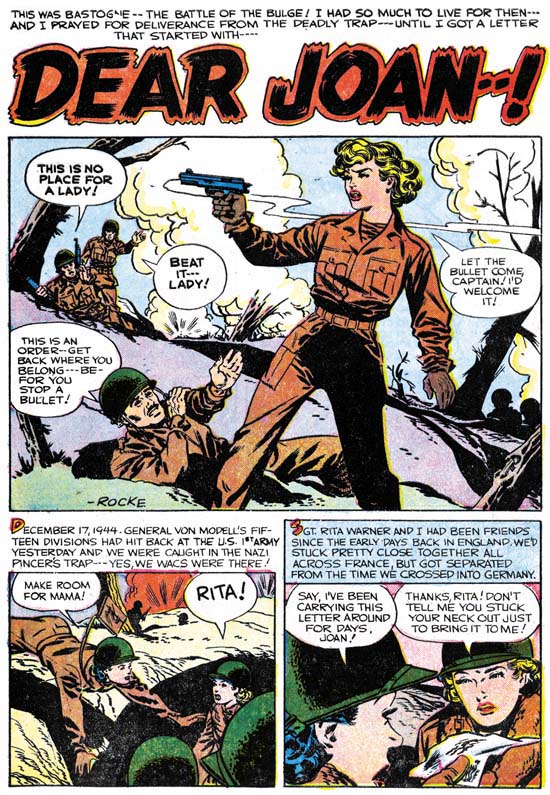
Foxhole #6 (September 1955) “Dear Joan” page 1 art by Rocco “Rocke” Mastroserio
A WAC gets caught in the Battle of the Bulge. While there a letter manages to reach her. It is from her fiance and it is the female equivalent of a “Dear John”. Despondent she goes of to the battle line with a discarded gun hoping to end her pain. She does get shot but is only wounded. Eventually she is taken back to a hospital to recover.
On the face of it this story might seem appropriate for Foxhole. It is after all not your typical war story. With six pages “Dear Joan” would seem to adhere to Foxhole formula of rather short stories. But page count does not tell all. Foxhole stories are general well crafted. It is hard to image how any part a Foxhole tale could be removed without it being severely diminished. They are like well polished gems. “Dear Joan” is not at all like that. Even with only six pages it seems to ramble. We learn from the letter the WAC receives about her romantic ties to a soldier. But then later we are given a flashback to how they met and feel in love. This flashback really seems superfluous. The handling of her attachment to a new soldier that happens in the end seems poorly done. The writing of “Dear Joan” just does not seem up to the Foxhole standard.
The art is signed “Rocke”, which is a nickname used by Rocco Mastroserio. I do not believe Rocke did any previous work for Simon and Kirby but he did have a long history with Charlton. The artistic vision Rocke supplies is also very much at odds with the rest of Foxhole. Although part of the story takes place when the American forces were trapped during the Battle of the Bulge the soldiers all seem clean cut with their uniforms in good shape. Even the heroine seems to be well groomed and wearing makeup. This is WWII as viewed by Hollywood at the time. This is not the sort of war portrayed in the rest of Foxhole.
With Mastroserio’s long involvement with Charlton and because the writing is so unlike the rest of the Foxhole stories, I suspect Charlton supplied this story to augment the rest of the S&K material.
There was a seventh issue of Foxhole published by Charlton. None of the artists for issue #7 had ever worked for Simon and Kirby as far I have been able to determine. The stories themselves are no longer the unique type of tales that are found in the other Foxhole issues. Rather Foxhole #7 has now become a standard war comic and a rather boring one at that. I can only conclude that issue #7 was a purely Charlton production without any input from Simon and Kirby. I understand that for issue #8 Charlton changed the title of the comic and Foxhole was no more. This sort of thing was done to save on postal registration fees and was fairly common. Charlton did the same thing when S&K’s In Love title was changed to I Love You with issue #7 although in that case Kirby supplied the cover.
This is the Simon and Kirby Blog so it should not come as a surprise that I am a big fan of much of the comics that Simon and Kirby produced. That is not to say that everything they put together was of equivalent merit, some of it was better then others. If I were to pick what I felt to be the best S&K title it would be Foxhole. This makes it truly regrettable that this title is out of print (although not out of copyright). Even beat up copies of the original Foxhole comics have become rather pricy. This title begs to receive the same sort of republication that Boys’ Ranch and Fighting American have already received.
But some of Foxhole have been reprinted. In Joe and Jim Simon’s “The Comic Book Makers” Joe describes selling some of the Mainline titles to Israel Waldman. The Foxhole work was published by Super Comics in 1964. The contents of Foxhole #1 was reprinted in Super Comic’s Foxhole #11, Foxhole #2 as Foxhole #12 and Foxhole #3 as Foxhole #18. Super Comics also printed some other comics using the Foxhole title but they do not contain any stories from the original Simon and Kirby’s Foxhole. In keeping with Super Comics general policy, the covers to their Foxhole reprints did not use the original cover art. I have noticed that in the last few years the price of Super Comics have risen dramatically. However this is for high grade books. Low grade Super Comics still show up at comic conventions or eBay from time to time at reasonable prices. The covers may be beat up but who cares, they are not Kirby’s covers anyway! The bad news is that Super Comics are not common so you may have to be patient and diligent.
In 1983 Charlton published two issues of their title Battlefield Action that contain some of the original Foxhole work:
Battlefield Action #83 (October 1983)
“Glide Into Glory” from Foxhole #5
“Morale” from Foxhole #5
“Kamakaze Joe” from Foxhole #5
Battlefield Action #84 (December 1983)
“Listen to the Boidie” Foxhole #6
“Even Steven” Foxhole #6
“Decision At Dieppe” Foxhole #6
“‘Hip Pockets’ and the Paper Bullets Foxhole #5
Again none of the original Kirby cover art. I have not been keeping track of Battlefield Action in the marketplace. Still with a 1983 publication date I would suspect that lower grade copies would be reasonably priced.
Reviewing all the Foxhole comics over a relatively short time has been very useful for me. It has allowed me to correct some early misattributions. By doing so I have come to see that Joe Albistur was even more important to Simon and Kirby productions then I had thought. For this short period of time Albistur is truly one of S&K’s usual suspects (along with Bill Draut, Mort Meskin and John Prentice). Joe Albistur’s Foxhole work has only increased my admiration for this fine but underrated artist. I have now reevaluated Bill Draut’s capabilities for drawing action. His early comic book work may have had some faults in this area, but he does some great action art in Foxhole. One thing that I have not mentioned yet is the absence of Mort Meskin in Foxhole. Actually Mort did little work for any of the Mainline titles although he was still drawing for Prize romance comics during this period. Mort seems to be the only one of the usual suspects who did not play a prominent part in the Mainline titles. I do not know why this should be but it seems worth investigating.
